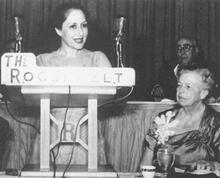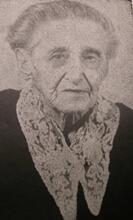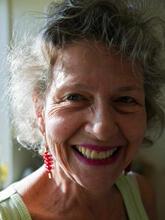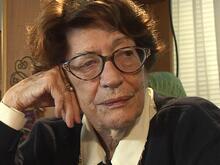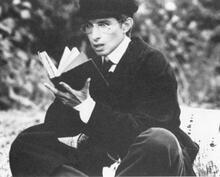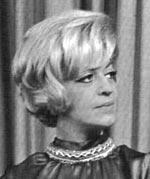Karen Sarhon
Multi-talented and multi-lingual, Istanbul resident Karen Gerson Sarhon is widely known as an authority in all aspects of Sephardic culture: language, music, food, folklore, theater, and literature. She is vocalist and co-founder (with Izzet Bana) of Los Pasharos Sefaradis, the first ensemble dedicated to Sephardic music in Turkey, with many recordings to its credit. She is the director of The Ottoman Sephardic Research Center in Istanbul, founded in 2003 through her initiative. She also serves as the editor-in-chief of El Amaneser, the only Judeo-Spanish (Ladino) language publication in the world today, and of the Ladino page of Şalom, the Jewish weekly newspaper of Turkey. Constantly involved with innovative projects to spread knowledge and enjoyment of the Ladino language, Karen is uniquely qualified to be called the doyenne of Sephardic culture today.
Multi-talented and multi-lingual, Istanbul resident Karen Gerson Sarhon is widely known as an authority on all aspects of Sephardic culture—language, music, food, folklore, theater, and literature. She is vocalist and co-founder (with Izzet Bana) of Los Pasharos Sefaradis, the first ensemble dedicated to Sephardic music in Turkey, with many recordings to its credit. She is also the director of the Sephardic Culture Research Center in Istanbul, founded in 2003 under the auspices of the Chief Rabbinate of Turkey through her initiative. Additionally she serves as the editor-in-chief of El Amaneser—the only Judeo-Spanish (Ladino) language publication in the world today—and of the Ladino page(s) of Şalom, the Jewish weekly newspaper of Turkey. Constantly involved with innovative projects to spread knowledge and enjoyment of the Ladino language, Sarhon is uniquely qualified to be called the doyenne of Sephardic culture today.
Multi-lingual Background and Education
Sarhon was born in Istanbul on May 25, 1958, to Suzi (Sultana) and Beni (Baruh) Gerson, in a community of Ladino-speaking Descendants of the Jews who lived in Spain and Portugal before the explusion of 1492; primarily Jews of N. Africa, Italy, the Middle East and the Balkans.Sephardic Jews whose ancestors had settled in the Ottoman Empire after the Expulsion from Spain in 1492. Although she heard Ladino spoken in her home when friends and family came to visit, her parents, having studied in the French schools of the city, decided to speak to their daughter in French. Her Ladino was thus not very fluent, and she learned Turkish only after starting elementary school and, starting in third grade, continued her French education with a private tutor. The English language entered her life next, when she matriculated at the English High School for Girls, a local British school. There she studied for five years—two years of preparatory classes to learn English and three years of secondary school. She went on to Istanbul's American Robert College, followed by Boğaziçi (Bosphorus) University, which she entered in 1976 and where she majored in English Philology and Linguistics.
In 1992, Karen Gerson married Jozi Yusuf Sarhon. Their daughter, Selin Sarhon, was born in 1996.
Expanding and Delving into Ladino
Sarhon’s studies at university, and her activities during those years, put her on the path to her future interests. As the English literature courses at the University were not challenging enough for her, she took extra courses from the Psychology department. She also participated in the activities of a Jewish youth club called Dostluk Yurdu (Friendship Home), which often involved speaking in Judeo-Spanish. She played a role in a musical, Kula '930, that parodied Jewish life in the Galata region of Istanbul during the 1930s. This turned out to be a milestone in her life. As she puts it: “I would never have learned to speak [Ladino] fluently if it hadn't been for my partner in the play, Jojo Eskenazi, whose native language was Judeo-Spanish. Jojo could never remember his lines exactly so he improvised every time we performed the play. In order to keep up with him, I paid a lot of attention to how my mother and her friends spoke when they gathered to play cards!” It was the first time Judeo-Spanish had become an important language in Karen's life.
Kula '930 became a classic in Turkish-Jewish theater. In the 1977-1978 season, it was performed 75 times, a record in the history of the community. On its tenth anniversary in 1987-1988, it was performed 50 times, including five times in Israel. In 2002-2003, its 25th anniversary was celebrated with an enlarged cast and many more performances for much larger audiences at bigger venues. Finally, in 2017-2018, Kula '930 celebrated its 40th anniversary with its initial cast and an additional younger cast, performing both in Turkey and in Israel as a fundraiser for student scholarships in both countries. Sarhon had a major role in all of these performances.
During her years at Dostluk, Sarhon realized that she was good at music and singing, and that she wanted to learn Spanish. She studied voice at the Istanbul Municipality Conservatory and attended Spanish language courses sponsored by the consulate of Spain.
Sarhon went on to obtain an MA in Social Psychology at Bosphorus University, where she wrote her interdisciplinary thesis in Sociolinguistics on "Language Change As Influenced By Cultural Contact – A Case: Ladino" (1983). This was the first time Judeo-Spanish had been the focus of an academic study in Turkey, so many people from the Jewish community came to hear her defend her thesis, as did many academics who were curious about the subject. Writing the thesis was not easy, as at the time there was hardly any material on Judeo-Spanish, academic or otherwise, and Sarhon had to depend on research done on Yiddish. “What my thesis showed me,” she says, “was that we, as a community, had this linguistic treasure that we had preserved for 500 years, a rare phenomenon in the world, and we didn't appreciate its value.”
Soon, another opportunity arose for Sarhon to focus on Ladino. In 1985, one year after she had begun to work as an English teacher and a member of the Testing Office at the Foreign Languages School of Boğaziçi University, she received a scholarship from the British Council to do an MA in Applied Linguistics at Reading University in the United Kingdom. Her thesis there was “The Relationship of Language Ethnicity and Ethnic Group Identity. A Case: Judeo-Spanish” (1986). After returning to Turkey, Sarhon continued to work at the university as an English language tester until 2003.
Los Pasharos Sefaradis (The Sephardic Birds)
In the early 1980s, Karen and Izzet Bana, her friend from Dostluk, began to collect songs from the older members of the Jewish community and founded the group Los Pasharos Sefaradis (The Sephardic Birds) in order to sing songs in Judeo-Spanish. Although they encountered resistance and derision from people in the community, who thought they were wasting their time with old music, they found appreciation from musicologists and ethnomusicologists from Europe and the United States who were in Turkey to research this music. They persevered and continued to collect and to perform. Since all the members of Los Pasharos Sefaradis (Karen Gerson Sarhon, Izzet Bana, Selim Hubeş, and Yavuz Hubeş) had grown up immersed in this music, they excelled in performing the songs that had been composed in the modes of Turkish classical music, a deep and complicated kind of music that Western musicians could not perform very well.
Los Pasharos Sefaradis became an increasingly popular ensemble in and outside Turkey, always performing live as amateurs. They came to be known as the most authentic Sephardic music group because they sang as their elders had done, with a true interpretation and correct enunciation of the lyrics. They first recorded audio cassettes, then later CDs. They also enriched their repertoire with new songs composed by Selim Hubeş. Los Pasharos Sefaradis was invited to multicultural concerts as representatives of the Turkish Sephardic community.
Ladino singer Karen Sarhon and the Sephardic music group Los Pasharos Sefaradis singing Leha Dodi, 2002
Karen Sarhon and the Sephardic music group Los Pasharos Sefaradis singing Ladino song “La Romansa de Rika Kuriel,” 2002.
In 2012, Karen Gerson and Izzet Bana began performing with professional Turkish musicians Ceyda Pirali, Günay Çelik and Türker Çolak.
In 2016, one of Sarhon’s dream projects was realized when Los Pasharos Sefaradis published its CD Tangos Sefaradis del Dip del Baul (Sephardic tangos from the bottom of the trunk), comprised of Judeo-Spanish tangos from the Ottoman Empire and a few new ones with lyrics by Sarhon.
The Sephardic Culture Research Center
In 1987, Sarhon had realized that a research center was needed in Istanbul to collect and preserve the Jewish community’s archives. She presented a proposal to the Turkish Jewish communal administration but received no response. When Karen retired in 2003 after 20 years of service at Boğaziçi University, Silvyo Ovadya, who was about to become the community’s president, offered to establish the research center she had proposed a decade and a half earlier. On December 1, 2003, Sarhon officially became coordinator of the Sephardic Culture Research Center in Istanbul. She reached out to Ladino academics, activists, and researchers around the world to help formulate the standardized Latin alphabet for writing and transcribing Ladino (traditionally written in Hebrew script). They adopted a system originally put forth by the Ladino cultural review Aki Yerushalayim (published in Israel from 1979 to 2016), a phonetic system used by Sephardim all over the world for personal and formal purposes, in publications, and in Internet groups such as Ladinokomunita, which has more than 1500 members worldwide.
One major accomplishment of the Center was creating and publishing El Amaneser (the Dawn) as an all-Ladino monthly supplement to the Jewish community's only newspaper, Şalom. For the first issue the editorial board received so much material that it appeared with twelve pages instead of the intended eight. For the rest of the first year, El Amaneser was published with sixteen pages, and from the second year on with 24 pages, proving the newspaper’s motto: Kuando muncho eskurese, es para amaneser (when it gets very dark, dawn is about to break). In 2018, El Amaneser began to publish a serialized insert, the transliteration into Latin letters of Meam Loez (a series of Torah commentaries in Ladino printed in Hebrew letters, started by Rav Yaakov Hulli in Istanbul in 1730 and continued after his death by other rabbis.) This first accurate transliteration of the Meam Loez is done by Yehuda Sidi in Israel, who, as a special favor to Sarhon, includes in parenthesis the definitions or synonyms of all words not in Judeo-Spanish, making the text much more comprehensible to the average reader.
Sarhon’s initiatives also brought more “first-ever” publications in Judeo-Spanish. A book of caricatures by Irvin Mandel, with captions translated from Turkish by Sarhon, appeared under the name of La Famiya Mozotros. She has also re-published, in Ladino only, four books of anecdotes, stories, and legends by Matilda Koen-Sarano, which had previously been published in Hebrew and Ladino. In 2010, Sarhon, working in the archives of the Alliance Israélite Universelle in Paris, came across a series of Ladino novels published in the 1930s in Istanbul as supplements to Jewish newspapers. She digitized sixteen of them, and the Center published them. Together with Klara Perahya, another pioneer in documenting Judeo-Spanish, she also published a re-edited version of the Judeo-Spanish–Turkish dictionary.
The Maftirim and Ladino Database Projects
Two long-term projects under Sarhon’s direction were finalized at the Center by 2010. One was the Maftirim project, which took six years to complete. Maftirim are paraliturgical Hebrew hymns that were sung by choirs in synagogues, especially on SabbathShabbat. This music, born and popularized in Edirne, has parallels with Sufi music and is sung in the makams (special melodic formulas) of Turkish classical music. The final product consisted of a 360-page book (in Turkish, English, and Judeo-Spanish), four CDs, and a DVD. Karen dedicated this undertaking to the late Rabbi Isaac Jerusalmi, who translated the extremely difficult Hebrew texts of the Maftirim poems into English and Ladino.
The second undertaking was the Ladino Database Project to record Judeo-Spanish in its spoken form. A team headed by Sarhon recorded interviews with 81 native or near-native speakers of Judeo-Spanish, resulting in a database of 80 hours of the spoken language.
Projects to Teach and Have Fun with Ladino
Two years ago Sarhon started a new project aimed at teaching the younger generations some Judeo-Spanish. The Un Biervo al Dia (One Word a Day) project, launched on social media, taught more than 300 words in Judeo-Spanish to more than 400 people (on WhatsApp only) in one year. It then advanced to Una Fraza al Dia (One Sentence a Day) for nearly another year. Sarhon also recorded ten lessons of Judeo-Spanish on Şalom newspaper's YouTube channel and produced many short videos (activities, songs, anecdotes, stories, caricatures, etc.) intended to teach Ladino in a fun way, with translation in Turkish and/or English.
Awards and Honors
Sarhon’s decades-long work with Ladino has not only been praised and appreciated in countless articles and radio and TV broadcasts and interviews, but it has also brought her awards and honors. In 2011 the French Ministry of Culture awarded her the medal of Chevalier des Arts et des Lettres de la République Française for her work in preserving and promoting an endangered language.
Ladino singer Karen Sarhon being awarded the Chevalier des Arts et des Lettres by the French Ministry of Culture, December 10, 2011.
In 2012, the online Women's Museum of Istanbul included Sarhon among the notable women of Istanbul. In 2017, the curator of the Women’s Museum, Meral Akkent, selected Sarhon as one of the seven important women in the history of Istanbul.
An avid reader and learner, Sarhon has a wide range of interests that include cooking, Reiki Healing, and Neuroscience, yet her main activity continues to be in the domain of the Sephardic culture. Besides carrying out her duties at the Sephardic Center, she advises Masters and PhD students writing theses on aspects of Sephardic culture. She continues editing books in Judeo-Spanish and is responsible for both El Amaneser and the Judeo-Spanish pages of the Şalom newspaper.
“I love learning and I love teaching what I have learned,” Sarhon says. “I love languages and feel very enriched with the five that I speak. I would like to learn a few more. Why not? There is no age limit to learning new things... I hope I have made a difference in the world with my work on our beautiful but very endangered language, Judeo-Espanyol. I have a thousand and one projects we can give life to, should we get the necessary funding. There is always so much to do and so little time to do them...” Then, in her beloved Judeo-Espanyol, she adds: “Ke mos biva esta lingua ermoza de muestros abuelos i el Dio ke mos de fuersa i enerjiya para luchar kontra su desaparision. Amen!” (Long live this beautiful language of our ancestors, and may God give us strength and energy to strive against its disappearance.)
Selected Works by Karen Gerson Sarhon
Sarhon, Karen Gerson, “Ladino in Turkey: The Situation Today as Reflected by the Ladino Database Project.” European Judaism, 44: Issue 1 (2011): 62–71.
Sarhon, Karen Gerson. “Judeo-Spanish: Where We Are, And Where We Are Going.” International Sephardic Journal 1, no. 1 (2004): 74-78.
Sarhon, Karen Gerson. “Culture and Music of the Jews of Turkey.” Jewish Renaissance Magazine 9, no. 2 (2010).
Discography
Los Pasharos Sefaradis Vol. I cassette, 1987
Los Pasharos Sefaradis Vol. II cassette, 1987
Los Pasharos Sefaradis Vol III cassette, 1987
La Romansa de Rika Kuriel cassette, 1988
Kantikas Para Syempre CD and cassette, 1995
Zemirot: Turkish-Sephardic Synagogue Hymns CD
(with 72-page booklet) and cassette, 2002
Kantikas Para Syempre CD, 2nd edition, 2003
Las Puertas double-CD, 2005
Tangos Sefaradis del Dip del Baul CD 2017
Selected Video
Karen Gerson Sarhon – Sephardic Humor and the Ladino Language: https://www.youtube.com/watch?v=hNeRsCEBfd8
Bali, Rifat “Şarhon, Karen Gerşon.” Encyclopedia of Jews in the Islamic World, edited by Avigdor Levy and Yaron Ayalon. Leiden: Brill, 2010.
Cembalest, Robin. “A New Dawn: After long decline, Latino in Turkey enjoys a modest revival.” Tablet, October 8, 2009. https://www.tabletmag.com/sections/news/articles/a-new-dawn
“Only Ladino Monthly Grows in Istanbul.” Arutz Sheva, September 6, 2013. http://www.israelnationalnews.com/News/News.aspx/168747#.UbYVH-c3CSq
Sarhon, Karen Gerson, private correspondence with the author.
Women’s Museum of Istanbul, http://www.istanbulkadinmuzesi.org/en/karen-sarhon







